Have you ever wondered about the types of verbs that don’t require an object to complete their meaning? These are called intransitive verbs.
Intransitive verbs are action words that express an action or a state of being without needing an object to receive that action.
7 Examples Of Intransitive Verb Used In a Sentence For Kids
- The butterfly flies in the sky.
- The bird sings on the tree.
- The river flows through the valley.
- The sun shines brightly in the morning.
- The flower blooms in the garden.
- The wind blows gently through the leaves.
- The cat sleeps peacefully in the sun.
14 Sentences with Intransitive Verb Examples
- Studying is essential for good grades.
- It is important to socialize with peers during college.
- Many students tend to procrastinate before exams.
- College students often party on the weekends.
- Students should network to build connections.
- It is common for students to struggle with time management.
- Many students relax by watching movies or reading books.
- Students often compete for top positions in their class.
- Some students excel in extracurricular activities.
- It is beneficial for students to reflect on their learning progress.
- College students frequently volunteer for social causes.
- Students sometimes worry about their future career prospects.
- Students often sleep late during exam periods.
- It is common for students to dream about their future success.
How To Use Intransitive Verb in Sentences?
Intransitive Verb
An intransitive verb is a verb that does not require a direct object to complete its meaning in a sentence. Here is a simple guide on how to use an intransitive verb in a sentence:
-
Identify the intransitive verb in a sentence. Look for a verb that does not require an object to make sense. For example, “run,” “laugh,” “sleep,” and “arrive” are all intransitive verbs.
-
Determine the subject of the sentence. The subject is the person or thing that is performing the action of the intransitive verb. For example, in the sentence “She runs every morning,” “She” is the subject.
-
Place the intransitive verb after the subject in the sentence. For example, “She runs every morning.”
-
You can add additional information to the sentence to provide more context, but remember that an intransitive verb does not require a direct object. For example, “She runs every morning in the park.”
-
Practice using intransitive verbs in different sentences to become more comfortable with identifying and using them correctly.
By following these steps, you can effectively use intransitive verbs in your writing to convey actions that do not require a direct object.
Conclusion
In conclusion, intransitive verbs are action verbs that do not require a direct object to complete their meaning. They express an action or state that does not act upon an object in a sentence. For example, “The bird sings” and “She sleeps peacefully” are sentences where intransitive verbs like “sings” and “sleeps” do not have objects but still convey a complete thought.
Understanding intransitive verbs is essential for constructing grammatically correct sentences and communicating effectively. By recognizing these verbs, one can accurately identify the action or state being described in a sentence without needing an object to receive the action. Practice with intransitive verbs can help enhance writing skills and improve the clarity of communication in both spoken and written language.



